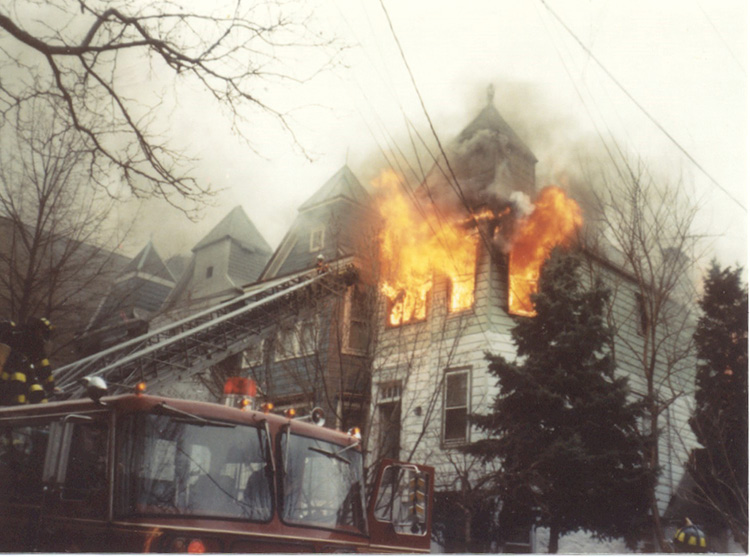
By ANTHONY AVILLO
What guides an incident commander in determining the strategic mode for operations? He bases this on—of course—arrival decisions, but he also bases it on the experience of the eyes on the incident. What a new officer might consider a major fire, an experienced officer might consider routine. Such is the business of firefighting.
We must answer two questions: (1) Can anyone be alive in this building? (2) How much of a primary search can we complete? Fire Department of New York Deputy Asistant Chief (Ret.) John Norman said, “When human life is at stake, an offensive [interior] attack is mandatory.” Norman further stated: “As long as there are people suspected within a building, firefighters are going to have to go in after them.”

(1) Heavy fire is in the front room, but what about the rest of the structure? Look at the whole picture. Don’t write off savable life. (Photos by Ron Jeffers unless otherwise noted.)
RELATED
Fireground Strategies: When Buildings Change the Rules of the Game
The Fire Conditions
Consider photo 1. If I had a dime for everyone who said, “This is a defensive fire,” I would not need my pension. Can anyone be alive in the structure? Absolutely—maybe not in the front room, but this space only accounts for a small portion of the structure. Based on Norman’s statement, if only about 10 percent of the building is involved, there is a definite possibility of people being alive in the structure. Regarding the second question about the extent of the primary search, although we can probably only do a limited search in the fire room, we can also get a thorough primary search in the rest of the structure, making this an offensive fire. People could be alive, so get in there!
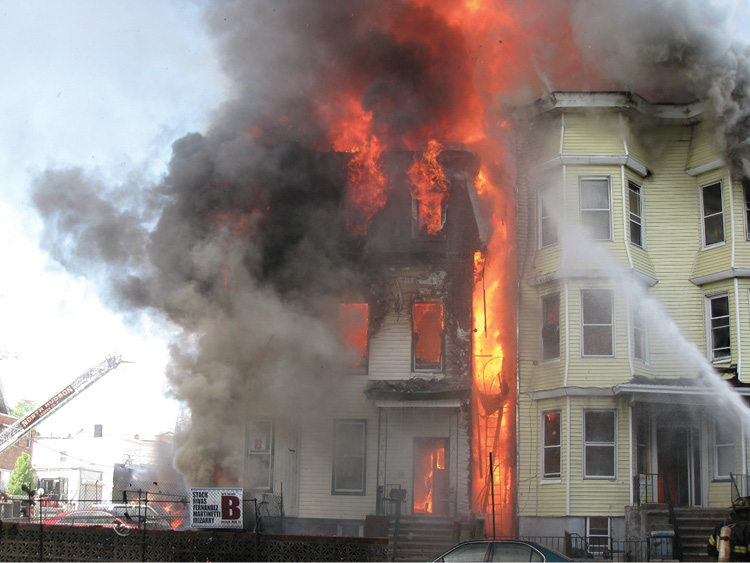
(2) This fire started on the outside as a vehicle fire and spread by asphalt siding into the building on the left. It is now involving the exposure. What risks will we take here?
As fire conditions increase in size and intensity, the survival profile of victims decreases, and our ability to do a thorough primary search becomes more limited. In photo 2, the building on the left is nearly fully involved while the building on the right is also involved but to a lesser extent—at the moment.
I do not recommend doing a primary search of the building on the left (fire building); there is almost no chance that anyone would be alive inside, and if they were in that first-floor area to the left of the front door, it would be a very limited grab-and-go (probably from the window). At this point, forget the rest of the building.
The building on the right (exposure D) must receive a very rapid, somewhat limited primary search. There is fire on the exterior and on the left (Bravo) side of the structure, including the front entrance hallway. The fire is moving from left to right, and rapidly! Consider a quick, limited primary search only if that search can be protected by a line to keep the fire to the left side of the building, which is not going to be easy. If this is the decision that has been made, ensure a secondary means of egress is in place on all floors.
If you cannot stretch a line to protect the search, do not attempt a primary search from the front door. The other option is vent-enter-isolate-search (VEIS). If you conduct VEIS operations, it is critical to close the doors to the search room. You can search only one room at a time; there is too much fire movement in the building, and it will want to move toward the flow path outlet created by the removal of a window for entry. Although we may be able to conduct a primary search here, it will be a very limited primary search rather than a thorough primary search because of the amount of fire spreading into and rapidly taking hold of the structure.
There may be cases, as in the situation that presents in the D exposure in photo 2, where we can extend some early lifesaving efforts. However, we must also understand when to discontinue those efforts because of the risks presented by rapidly spreading fire. Recognize the present conditions, weigh them against your staffing and operational capabilities on scene NOW (not what you may eventually have), and forecast the potential for spread. Do what you can to save a life—risk everything, when warranted—but understand the prospect of life that is not savable, and balance risk with reward in all cases.
Questions for Strategic Direction
Consider the impact of the following questions. These questions, alone or in combination, are also instrumental in the strategic mode decision.
What is causing the main concern (fire, hazmat, technical rescue, and so on)? We often base our strategic decisions on what is causing the problem. We can handle most of our concerns with fire incidents with an offensive mode of attack. Again, we need to determine if there is any savable life inside the building. If so, send firefighters in to bring victims out, signifying the need to operate aggressively and offensively.
When our main concern is something more technical such as a hazardous materials or technical rescue incident, slow things down, gather information, and ensure the proper resources are requested. At these incidents (especially for hazardous materials), choose a more conservative mode of operation. Defensive operations and nonintervention strategies are required when hazardous materials are involved.
For technical rescues, the chosen strategic mode will depend on how well versed the department is in these operations. Understanding that the requirements for a technical rescue operation are quite different from those for a fire operation, most times, the incident is handled in a slow and steady manner aimed at ensuring all tech rescue requirements are met and all responders are operating safely. Be careful not to get in over your head with an aggressive approach to an issue that may be best handled by someone else.
What is the life hazard (firefighter, civilian)? As stated, when human life is involved, we not only risk a lot, we risk everything. The extent to which savable human life is involved will determine exactly how we go about working the incident. Civilian life takes precedence over all other concerns. When civilian life is not endangered or when civilians are not likely to be still alive during an incident, then the firefighter life hazard must be the biggest consideration. Firefighter and fire officer experience as well as the ability to control emotions will play a big part in how the incident is handled regarding the perceived life hazard.
How much of the building is involved at this time? Arrival conditions will dictate which quick actions you may take to address the situation at hand. Experience is a great attribute to determine whether you operate on the interior of the building or begin your operation in a defensive mode. What looks like a big fire to a novice may be a routine fire to an experienced officer.
The key is to size up the building and situation and determine not only the fire’s location but, based on your knowledge of building construction and the paths of least resistance, what actions to take to stop the spread so you can get in and conduct interior operations including primary search and fire attack.
In some instances, it may be best, especially with limited staffing, to make a quick hit on the fire from the exterior to cool things down and then make an aggressive attack on what’s left (a transitional attack). This may not only make interior conditions more tenable but also save lives in areas where fire has not yet spread. This transitional attack may very well limit how much of the building stays involved and buy time for those interior operations that are aimed at removing victims and confining the fire. The fire does not know from where the water is coming, and nothing ever got worse by putting water on a fire. Active cooling makes the building more tenable for lifesaving efforts that may not have been possible with an untamed fire.
How much of the building is uninvolved and threatened? This question is the opposite of what was stated above. If we determine how much of the building is involved, then we will know how much is uninvolved; this is fairly obvious. However, the real trick is to determine which areas are threatened and which are not. Early and continuous notifications and progress reports will help command determine which areas to protect first, in which areas to extend more aggressive searches, and which areas to potentially surrender to do the most good for all involved. Further, these reports may cause command to stretch interior defensive lines to protect interior exposures and conduct such operations as vent-enter-search in areas that are threatened but not yet involved. Aggressive exposure control, whether interior or exterior, may require additional staffing and the need to prioritize which areas receive more aggressive attention and which do not. The main focus should always be to keep what is uninvolved and not yet part of the fire problem from becoming the fire problem (photo 3).
Has structural stability been compromised? When the structural stability of the building is in question, the only alternative for command is to operate defensively in the area of structural instability. Depending on the size of the building, the location, and the rapidity of fire spread, it may be possible to continue to operate in threatened exposures while operating defensively in the area of structural concern.
Again, command must continuously request reports because the areas in question may not be in direct view of the command post. Operating companies should also be on the lookout for conditions that may lead to structural instability such as heavy loads on a roof, water runoff issues, heavy fire conditions, and observation of lightweight construction involvement (photo 4).
What is the personnel and apparatus profile? Fires are put out by people and equipment. Limitations on staffing will hinder our ability to meet the demands of the incident. When the demands of the incident outstrip staffing, proactive requests for mutual aid are a step in the right direction. Automatic aid is an even bigger step. In these cases, you may need to assign current on-scene resources as per the priorities of the incident. If there are life hazards in the fire building, especially those that are credibly reported or can be seen and heard, direct all resources toward supporting the rescue operation. Additionally, keep in mind that putting the fire out makes all the problems go away. That said, circumstances must dictate actions to address the most critical issues of the incident. For instance, when you arrive to a well-involved structure, limited on-scene resources may be better used in exposure protection rather than in fire suppression. The philosophy that it is better to lose one building than to lose many can be justified if life hazard in the fire building is nonexistent. The key to strategic decision making regarding staffing is to try to get done what you can get done with your current staffing and not overextend too far beyond your capabilities because that is when injury and fatality become more likely.
Can you get water on the fire? Water puts out fires. Whether you are using a transitional attack from the exterior to quickly knock down an angry body of fire or aggressively advancing the line inside to the fire area, the fire does not know where the water is coming from. Putting water on the fire never made things worse. All your other problems go away when the fire is controlled. Do not waste any time in using as many personnel or engine companies as you need to get that first line into place. It will serve to not only protect egress but, if it is properly placed, it will also confine the fire to the smallest possible area. Failure to get water on the fire will cause the fire to spread exponentially and jeopardize all other operations. Some fires can double in size every 18 seconds; if we can’t stop that from happening, the situation will get worse (photo 5).
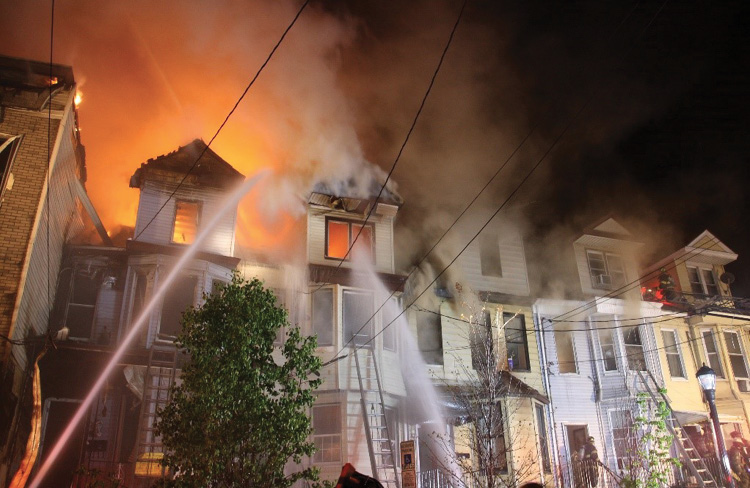
(3) Multiple strategic modes are in place at this incident. As the fire spreads toward the buildings on the D side, more aggressive interior operations (interior defensive) must take place to keep the fire confined to its present location and stop the spread. At this point, these buildings should all have been searched and evacuated, so the life focus now becomes one of firefighter safety, and the strategic focus centers on limiting damage.
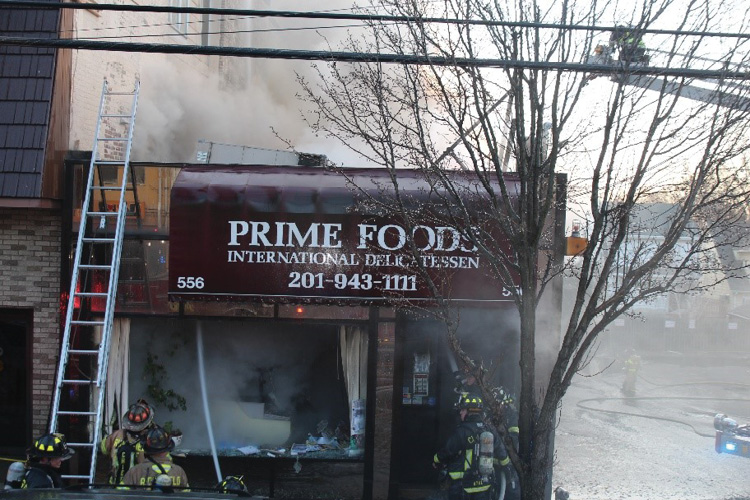
(4) One look at the heating, ventilating, and air-conditioning unit sinking through the roof is a cue that you should pursue a defensive mode of operation. Although it looks like this operation is semi-defensive in nature (semi-defensive is NOT a strategic mode), the lines are certainly in the collapse zone, and the line in the doorway on the right is in a critically unsafe position.
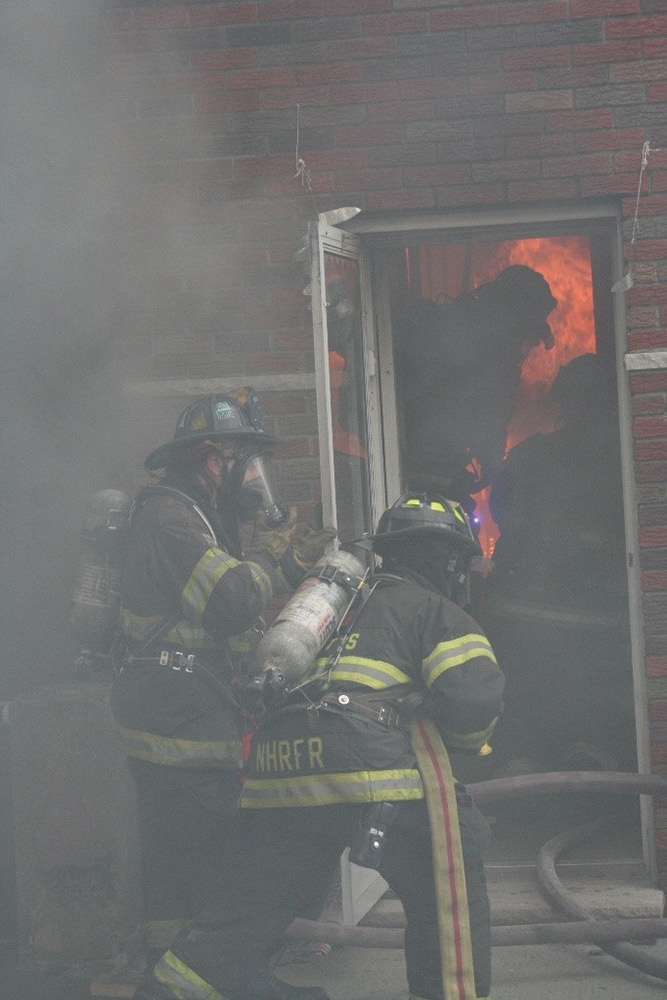
(5) No matter how or from where it is applied, water on the fire never made things worse.

(6) The upper floors of this building are not going to cooperate with ventilation efforts. Consequently, it will be nearly impossible to control this fire as it spreads upward.
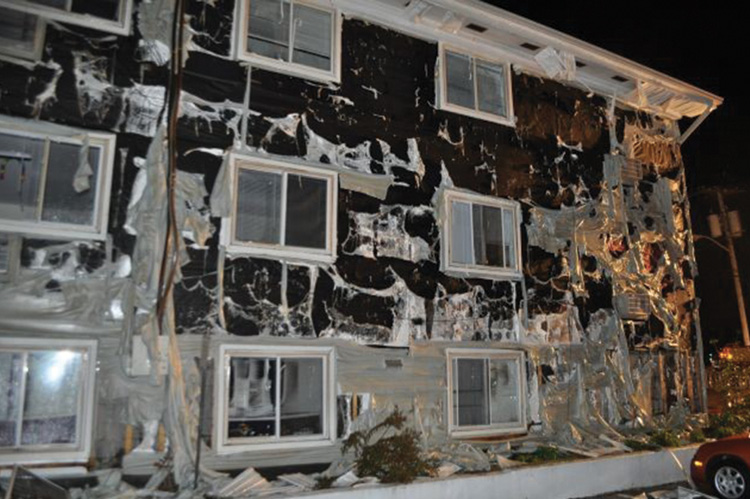
(7) This building was exposed to a lot of radiant heat. Without protective efforts, it would have become another part of the problem. This requires people! (Photo by author.)
Can you control the flow paths and vent the building? Controlling the flow paths and keeping the “beast in the cage” until we are ready to apply water will allow us to make the building and the fire behave. Failure to control flow paths will cause fire to spread to uninvolved areas, result in flashover, jeopardize victims in other parts of the structure, and endanger searching firefighters. Keep that in mind, and control all doors and windows. Once you have water at the fire area and are in an attack position, you can begin to vent in a coordinated and systematic manner. If the situation presented does not allow for an efficient ventilation operation such as in wind-driven fire conditions or bricked-up windows, you may have to opt for defensive measures or more creative tactics to provide for fire control. It is very tough to maintain an offensive position if we cannot effectively vent. Keep an eye on the building and an ear on the progress reports to determine how your attack/vent profile looks, and adjust accordingly (photo 6).
How threatened are the exposures? If you work in an urban area like North Hudson, New Jersey, you will never have a fire without an exposure problem (or two or three). Do you protect exposures, or do you fight the fire? With limited staffing, you may not be able to do both. Again, the answer should lie in your assessment of “Can anyone be alive?” and “How much of a primary search can we complete?” If no one can be alive in the fire building, it might make more sense to protect exposures because it is better to lose one building than to lose two or three. Conversely, if a search is required, it is best to support the operation, even if it requires all available personnel. Make sure you summon additional resources early enough to address exposure issues. Never choose exposures over savable lives (photo 7).
Has anything “nasty” presented itself? This may be information that does not get presented initially, but it becomes part of the incident as companies enter, survey the building, and discover these aspects. Hazardous materials, bombs, drug labs, and major structural deficiencies are all issues that may be part of a progress report or urgent message from companies already engaged inside the structure. This may lead to a quick change in strategy. Never take any surprise lightly. Consider the big picture and adjust the strategy accordingly.
How quickly can additional resources get to the scene? Just as water puts out the fire, putting water on the fire requires resources: people and equipment. If your initial response is limited in its capabilities, do not wait to request additional assistance. At the same time, consider whether the plan that is evolving in your head and being carried out by your companies is feasible without proper assistance and support. Fire spread on the interior of the fire building may jeopardize or overwhelm your crew’s efforts, causing Mayday situations and casualties with frightening rapidity, especially for companies operating belowgrade or above the fire. Be realistic about what you can accomplish with what you have on scene, plan on what you can do when help arrives, and balance that with the safety considerations and risk/reward that exist now or are expected. Be careful about overextending your influence on the incident.
What, if any, special circumstances must be considered at this incident? Extremes of weather, utility issues, barriers to proper fireground activities (accessibility), and just plain “weird” fireground incidents all play a role as to what extent and how effectively you can carry out your strategy and tactics. Just like the “nasty” things referred to earlier, these issues usually come about or are discovered while conducting operations. They also provide a greater degree of danger, requiring more time to sort out and more personnel to address the issue. When you are made aware, act. Make a decision, get more information, monitor as needed, or change the strategy accordingly.
As I stated in the first paragraph, the questions, “How much of a primary search can we complete?” and “Can anyone be alive in this structure?” will guide most strategic decisions. Add to that the additional questions discussed here, throw in a healthy dose of common sense based on a realistic risk/reward profile and fireground experience, and you have a good formula to make these strategic decisions with a good degree of confidence. In a marginal situation, erring on the side of safety will often allow a better assessment of the situation and allow for adjustment. Rushing in without thinking or assessing almost always sets the stage for disaster.
ANTHONY AVILLO, M.S., is a 34-year fire service veteran. He retired as a deputy chief in North Hudson (NJ) Regional Fire & Rescue. He has a master’s degree in national security studies and a BS degree in fire science from New Jersey City University, where is he also an adjunct professor. Avillo is the director and deputy fire marshal at the Monmouth County (NJ) Fire Academy, an FDIC International instructor and a member of its advisory board, and a member of Fire Engineering’s editorial advisory board. He is the author of Fireground Strategies, 3rd edition (Fire Engineering, 2015) and Fireground Strategies Workbook Volumes I, II, and III (Fire Engineering, 2002, 2010, 2016) and co-author of Full Contact Leadership (Fire Engineering, 2017). He was a contributing author to Fire Engineering’s Handbook for Firefighter I and Firefighter II (Fire Engineering, 2009, 2018) and is co-author of its study guide (Fire Engineering, 2010). Avillo received the 2012 Fire Engineering/ISFSI George D. Post Fire Instructor of the Year Award.

